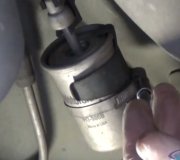You should be replying to the original post that you were directed to through the link in the automated e-mail rather than starting a new question.
Every vehicle has rubber fuel hose between the tank and metal lines on the frame and those lines and the engine. Many have rubber hoses connecting to the fuel filter along the frame rail too. It is also acceptable in most states to splice in a section of rubber hose to replace a rusted steel line, but there are some things you need to consider. First of all, when a steel line rusts away, the rest of it is just as old and there's likely to be more bad sections, and possibly in hidden places where you can't see it but where salt gets stuck in winter. Second, you must use high-pressure fuel injection hose, not the less-expensive stuff that works with carbureted engines. Fuel pumps for carburetors develop between three and five pounds of pressure. A few fuel injection systems run as low as nine to 14 pounds, but most can easily get over 50 psi. Fuel injection hose is made to withstand that pressure. Third, you'll want to use special fuel injection hose clamps. Those are a band that is tightened with a bolt and nut, and the edges are rolled up a little to prevent the sides from cutting into the rubber. The common aircraft-style, worm screw clamps will bite in to the hose and will often let go and not hold the hose tight. Finally, be aware that the high fuel pressure will try to push the rubber hose off the metal pipes. The clamps are only for sealing the hose to the pipe. To prevent the hose from sliding off, you need to prepare the pipe ends by removing any burrs or sharp points, then you must cut some grooves into the pipes for the rubber to grab onto. You might try using a file to make some grooves, but a better alternative is to use a brake line double-flaring tool but just do the first step of the procedure. That will leave a small bell on the end of the pipe. The clamp with the hose won't be able to slide over that.
At around $4.00 per foot for fuel injection hose, you might consider using steel brake line instead. That way you'll just need two short pieces of hose to connect the new line to the old one. If you visit a nearby Chrysler dealership, their replacement fuel filters for '90s model cars often come with short pieces of hose, and every mechanic has extra ones in his tool box. They'll probably be happy to give you a few.
Hose routing is important too. Steel line won't be damaged by rocks that are thrown up against it. Rubber hose usually won't be damaged either but replacement steel line is almost impossible to form just like the old one and to feed it through all the holes brackets. Rubber hose can't be routed the same way because the tight corners will make it kink. You need to keep the new line away from hot exhaust parts and anything that moves that can rub against it. That includes parking brake cables, height-sensing brake proportioning valves, springs and shock absorbers, and things like that. Leave the old line in place and use it as an anchor to tie the new line up with tie straps. It's very easy for a hose that's hanging down just a little to snag a tree branch on the ground.
Wednesday, August 20th, 2014 AT 3:02 AM


